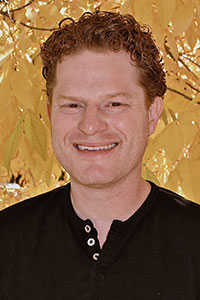Most imaging scientists will tell you that scattered light — rays of light that get rerouted when ping-ponging between obstacles in a frame — is the sworn enemy of clear, crisp biomedical images.

But Randy Bartels envisions a different outcome: By harnessing the chaos of scattered light, it may open up unseen worlds in live biology imaging.
Bartels, a biomedical imaging investigator at the Morgridge Institute for Research, received a Deep Tissue Phase 2 Frontiers of Imaging award on Feb. 13 from the Chan Zuckerberg Initiative (CZI) to develop a new approach to deep tissue imaging. The project addresses a roadblock in biology’s long-sought goal to see inside living tissue to better understand both normal function and disease.
Bartels, also a UW–Madison professor of biomedical engineering, describes the current imaging challenge as the “ballistic barrier.” Normally, researchers want to maximize ballistic light, which is in a straight-line, highly precise trajectory that can penetrate into tissue and provide clear pictures. Think of ballistic light like a bullet slicing through a dense forest and never hitting a tree.
But just as a bullet travelling through a forest will eventually hit a tree, light will inevitably be scrambled by scattering as the light propagates in tissue. Thus, according to Bartels, two problems arise in the imaging process. First, light propagating through tissue is robbed of its precision by all of the “background noise” of scattered light. Second, even when techniques are used to suppress scattered light, the intensity of ballistic light decays exponentially as it moves more deeply into tissue — hence, the ballistic barrier.
Bartels’ end-run around this barrier will involve developing new imaging technology based on coherent nonlinear imaging (CNI). The new work offers new ways to unscramble, remap and control light that is exiting through the tissue. This technique has the potential to expand imaging depths as much as five times beyond current methods.
“Instead of having to disregard all of the light that is getting scattered and randomized in our images, we embrace it, we exploit that randomness,” Bartels says. “And we can use the statistical properties of that random illumination to image at greater depths.”
Going deeper and clearer into tissue with microscopy would offer profound benefits to understanding health and disease. Imagine being able to image — non-invasively — into a patient to get a clear picture of diseased tissue and how it interacts with the healthy tissue environment. Bartels says one dream outcome of this field would be to expand the capabilities of minimally invasive optical biopsies.
The four-year project will begin with perfecting the microscope design, then applying the technology to image thick human tissue samples containing collagen and muscle that will produce strong second harmonic generation signals. Collagen is especially important to image because it often gets remodeled inside the body by diseases such as cancer, to promote growth of the disease.

Collaborators on the project include: Kevin Eliceiri, Morgridge investigator and UW–Madison professor of biomedical engineering; Paul Campagnola, UW–Madison professor and chair of biomedical engineering; Olivier Pinaud, Colorado State University; Anne Sentenec, the Fresnel Institute in France; Herve Rigneault, Fresnel Institute; Hilton B. de Aguiar, the Kastler Brossel Laboratory in France; and Sylvain Gigan, Kastler Brossel Laboratory.
